When you're feeling anxious, turn to your kitchen for relief. Cooking together can be a powerful therapy, stimulating feel-good hormones and promoting mindfulness. Choose a compatible cooking partner and create a stress-free kitchen environment to maximize benefits. Plan meals that incorporate anxiety-reducing ingredients and focus on mindful preparation techniques. As you work side by side, you'll build trust, improve communication, and boost confidence through shared culinary experiences. Don't forget to savor the process and practice mindful eating when enjoying your creations. By exploring this unexpected form of anxiety relief, you'll discover a whole new world of emotional and culinary satisfaction.
The Science Behind Cooking Therapy
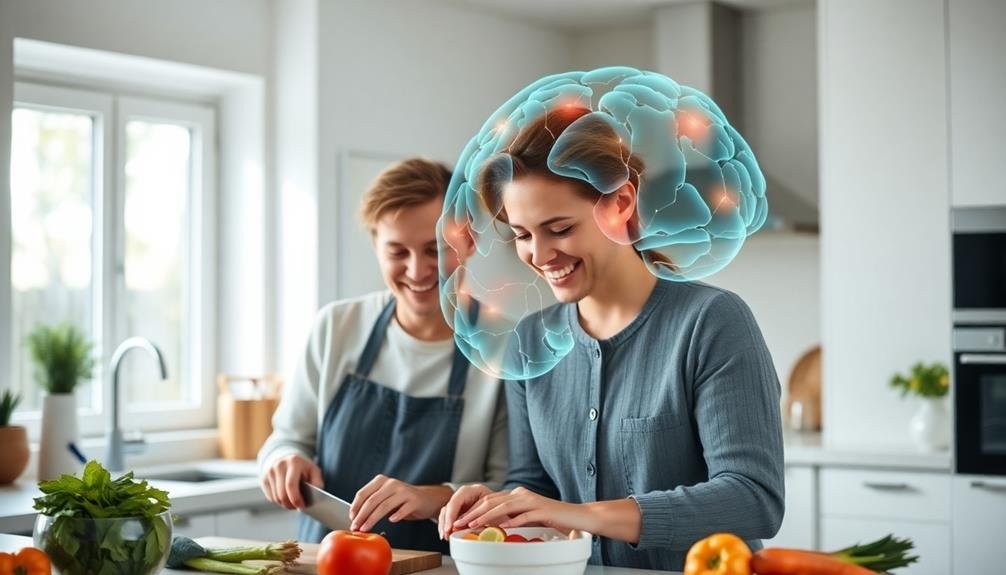
Exploring the science behind cooking therapy reveals its powerful impact on mental health. When you engage in cooking activities, your brain releases neurotransmitters like dopamine and serotonin, which are associated with pleasure and mood regulation. This chemical response can help alleviate symptoms of anxiety and depression.
Cooking therapy also engages your senses, promoting mindfulness and grounding you in the present moment. As you focus on chopping vegetables, measuring ingredients, and following recipes, you're practicing a form of meditation that can reduce stress and intrusive thoughts.
The act of creating something tangible provides a sense of accomplishment and boosts self-esteem. This can be particularly beneficial for those struggling with anxiety, as it reinforces feelings of capability and control.
Moreover, cooking with others fosters social connections and support, which are essential for mental well-being. The collaborative nature of group cooking activities encourages communication, teamwork, and shared experiences, all of which can help combat feelings of isolation often associated with anxiety disorders.
Research has shown that cooking therapy can lead to improved emotional regulation, increased self-efficacy, and reduced symptoms of anxiety and depression in participants.
Choosing Your Cooking Companion
When selecting a cooking partner to help alleviate anxiety, you'll want to take into account a few key factors.
First, assess your respective skill levels to guarantee a balanced and enjoyable experience in the kitchen.
It's also essential to choose someone with a compatible personality and shared culinary interests, as this will foster a more relaxed and productive cooking environment.
Assess Skill Levels
A crucial step in choosing your cooking companion is evaluating skill levels. You'll want to guarantee that you're both comfortable and can work together effectively in the kitchen. Consider your own culinary expertise and that of your potential partner. Are you both beginners, or is one of you more experienced? This assessment will help determine the types of recipes you can tackle and how you'll divide tasks.
| Skill Level | Characteristics | Suitable Recipes | Cooking Approach |
|---|---|---|---|
| Beginner | Basic knowledge | Simple, few ingredients | Step-by-step guidance |
| Intermediate | Familiar with techniques | Moderately complex | Collaborative effort |
| Advanced | Skilled in various cuisines | Challenging, gourmet | Experimentation |
| Expert | Professional-level | Multi-course meals | Mentoring, teaching |
Once you've identified your skill levels, you can choose recipes that match your combined abilities. If there's a significant difference, the more experienced cook can take on a mentoring role, teaching new techniques and sharing tips. This approach can be particularly beneficial for anxiety relief, as it fosters a supportive environment and promotes learning. Remember, the goal is to create an enjoyable, stress-free cooking experience for both of you.
Consider Personality Compatibility
Personality compatibility plays an essential role in choosing your cooking companion for anxiety relief. When selecting a partner, consider their temperament and how it aligns with yours. If you're easily stressed, pairing with someone calm and patient can help create a soothing atmosphere. Conversely, if you tend to be overly cautious, a more adventurous partner might encourage you to step out of your comfort zone.
Think about communication styles as well. Do you prefer someone who gives clear instructions, or do you thrive with a more collaborative approach?
Consider energy levels too. If you're prone to anxiety-induced fatigue, a high-energy partner might be overwhelming. Instead, look for someone who matches your pace.
Don't forget to assess how you handle mistakes. A supportive companion who can laugh off burnt cookies or a fallen soufflé can greatly reduce anxiety in the kitchen.
Ultimately, choose someone who complements your strengths and weaknesses, creating a balanced cooking dynamic. Remember, the goal is to create a positive, stress-free environment where you can focus on the joy of cooking and the therapeutic benefits it offers.
Share Culinary Interests
Beyond personality compatibility, shared culinary interests can greatly enhance your cooking experience and anxiety relief. When choosing a cooking companion, consider their food preferences and expertise. If you're both passionate about Italian cuisine, you'll likely enjoy exploring new pasta recipes together.
Similarly, if you're both health-conscious, you might find joy in creating nutritious meals. Discuss your favorite dishes, cooking techniques, and culinary goals. Do you want to master baking? Are you interested in exploring international flavors?
Finding common ground will make the cooking process more enjoyable and less stressful. You'll be able to bounce ideas off each other and learn from one another's experiences.
Don't be afraid to step out of your comfort zone together. Try cuisines you've never attempted before or challenge yourselves with complex recipes. This shared adventure can strengthen your bond and provide a sense of accomplishment.
Setting Up a Stress-Free Kitchen
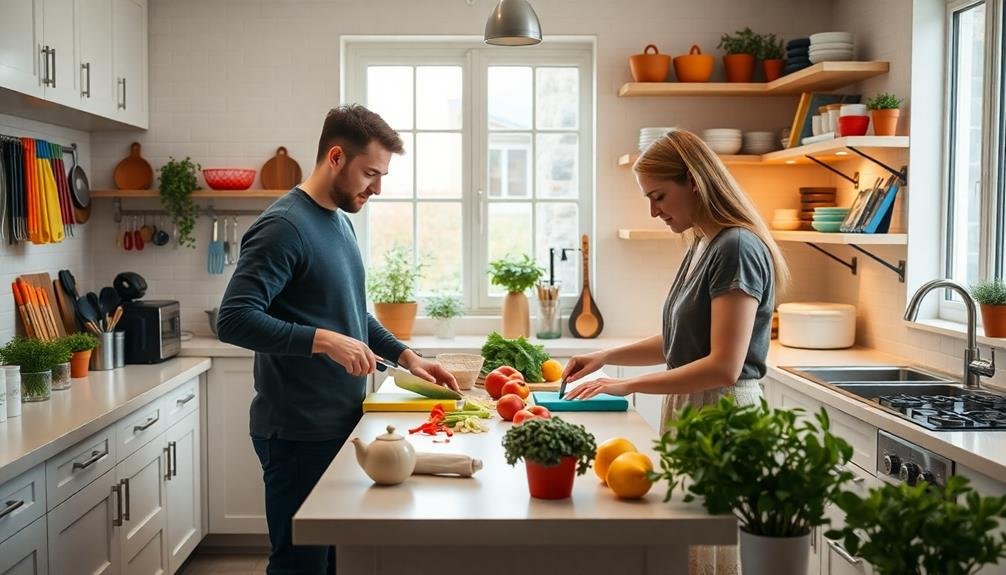
How can you create a kitchen environment that promotes calm and ease while cooking? Start by decluttering your space. Remove unnecessary gadgets and keep only the essentials within reach.
Organize your tools and ingredients in a logical manner, making them easily accessible. Consider using clear containers to store dry goods, allowing you to see what you have at a glance.
Ensure proper lighting in your kitchen. Natural light is ideal, but if that's not possible, install bright, warm-toned lights to create a welcoming atmosphere.
Add some plants to bring a touch of nature and tranquility to the space.
Invest in quality, ergonomic tools that feel comfortable in your hands. Sharp knives and well-maintained equipment can greatly reduce frustration during food preparation.
Keep a small speaker in the kitchen to play calming music or your favorite podcasts while you cook.
Create a designated prep area with ample counter space. Use non-slip mats to prevent accidents and reduce anxiety about spills.
Meal Planning for Anxiety Management
When it comes to managing anxiety through cooking, meal planning can be a game-changer. By planning your meals in advance, you'll reduce decision fatigue and minimize last-minute stress.
Start by setting aside time each week to plan your meals and create a shopping list. Consider your schedule and choose recipes that fit your time constraints and skill level.
Incorporate anxiety-reducing foods into your meal plan, such as those rich in omega-3 fatty acids, magnesium, and B vitamins. Think salmon, leafy greens, nuts, and whole grains.
Don't forget to include comfort foods that bring you joy and nostalgia.
Prep ingredients in advance to make cooking during the week easier. Wash and chop vegetables, cook grains, or marinate proteins. This way, you'll have less to do when it's time to cook, reducing potential stress.
Be flexible with your plan. If you're not feeling up to a particular meal, have backup options ready. Keep some easy-to-prepare meals or healthy frozen options on hand for days when cooking feels overwhelming.
Mindful Ingredient Selection
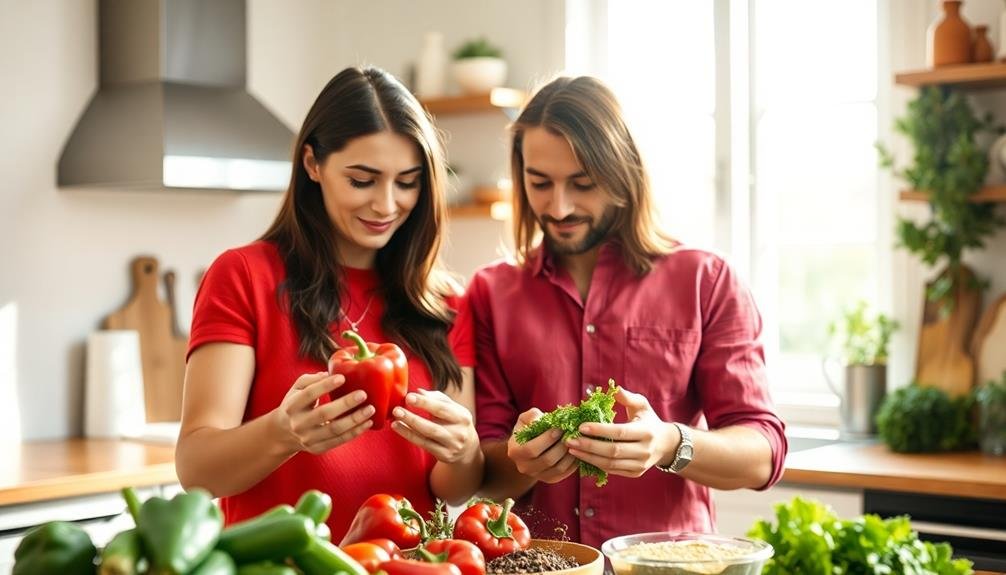
Mindful ingredient selection plays an essential role in cooking for anxiety relief. When you're choosing ingredients, focus on foods known to support mental health. Opt for omega-3 rich fish like salmon, mackerel, or sardines, which can help reduce anxiety symptoms.
Include complex carbohydrates like whole grains, quinoa, and sweet potatoes to stabilize blood sugar and promote serotonin production.
Don't forget to incorporate antioxidant-rich fruits and vegetables. Berries, leafy greens, and citrus fruits can help combat oxidative stress associated with anxiety.
Choose magnesium-rich foods like nuts, seeds, and dark chocolate to support relaxation. Probiotic-rich options like yogurt and kefir can also positively impact your gut-brain connection.
When selecting proteins, opt for lean sources like chicken, turkey, or plant-based alternatives. These provide essential amino acids for neurotransmitter production.
Avoid caffeine, alcohol, and excessive sugar, as they can exacerbate anxiety symptoms. Instead, choose calming herbal teas like chamomile or lavender.
Collaborative Recipe Creation
When you're creating recipes together, start by brainstorming exciting flavor combinations that spark your imagination.
Work on balancing complementary ingredients to achieve a harmonious dish that satisfies everyone's taste buds.
Don't forget to share your cultural culinary knowledge, as this can lead to unique fusion recipes and a deeper appreciation for diverse cooking traditions.
Brainstorming Flavor Combinations
Diving into the world of flavor combinations can be an exciting way to bond with your cooking partner and reduce anxiety. Start by selecting a base ingredient and brainstorm complementary flavors. Don't be afraid to think outside the box – unusual pairings often lead to delightful discoveries.
Consider the five basic tastes: sweet, salty, sour, bitter, and umami. Aim to balance these in your dish for a well-rounded flavor profile. Experiment with herbs and spices, exploring how they interact with your main ingredients. For example, pair basil with strawberries or rosemary with lemon.
Use a flavor wheel as a visual aid to guide your brainstorming session. This tool can help you identify flavor families and potential combinations you mightn't have considered. As you discuss ideas, write them down to keep track of your thoughts.
Challenge each other to come up with at least three unique flavor combinations. This exercise encourages creativity and helps shift focus away from anxious thoughts. Remember, there are no wrong answers in brainstorming – embrace the process and have fun with it. You might stumble upon your next favorite dish while reducing stress together.
Balancing Complementary Ingredients
After brainstorming exciting flavor combinations, it's time to put your ideas into action through collaborative recipe creation. Focus on balancing complementary ingredients to create a harmonious dish.
Start by selecting a primary flavor or ingredient as your dish's foundation. Then, choose secondary elements that will enhance and support the main component.
Consider texture, acidity, sweetness, and umami when pairing ingredients. For example, if you've chosen a rich, fatty protein like salmon, balance it with a bright, acidic element like lemon or a crisp vegetable.
Pay attention to cooking methods that will bring out the best in each ingredient. As you work together, discuss how different ingredients might interact and adjust quantities accordingly.
Don't be afraid to experiment with small amounts of bold flavors to add depth to your dish. Remember that balance doesn't mean every flavor should be equal; instead, aim for a well-rounded experience where each element contributes to the overall taste.
Sharing Cultural Culinary Knowledge
Collaborative recipe creation offers a unique opportunity to share and explore diverse cultural culinary traditions. As you cook together, encourage each participant to bring a recipe from their heritage or a cuisine they're passionate about. This exchange of knowledge not only broadens your culinary horizons but also fosters a deeper understanding and appreciation of different cultures.
When sharing recipes, discuss the ingredients' origins, traditional cooking methods, and the dish's significance in its culture. You'll find that many cuisines have similar dishes with unique twists, highlighting the interconnectedness of global food traditions.
| Culture | Dish | Key Ingredient |
|---|---|---|
| Italian | Risotto | Arborio rice |
| Japanese | Donburi | Short-grain rice |
| Spanish | Paella | Bomba rice |
As you explore these cultural differences, you'll discover new techniques, flavors, and ingredients to incorporate into your cooking repertoire. This shared learning experience can help reduce anxiety by creating a sense of community and mutual understanding. It also provides a platform for cultural exchange, fostering respect and appreciation for diverse traditions through the universal language of food.
Cooking Techniques for Relaxation
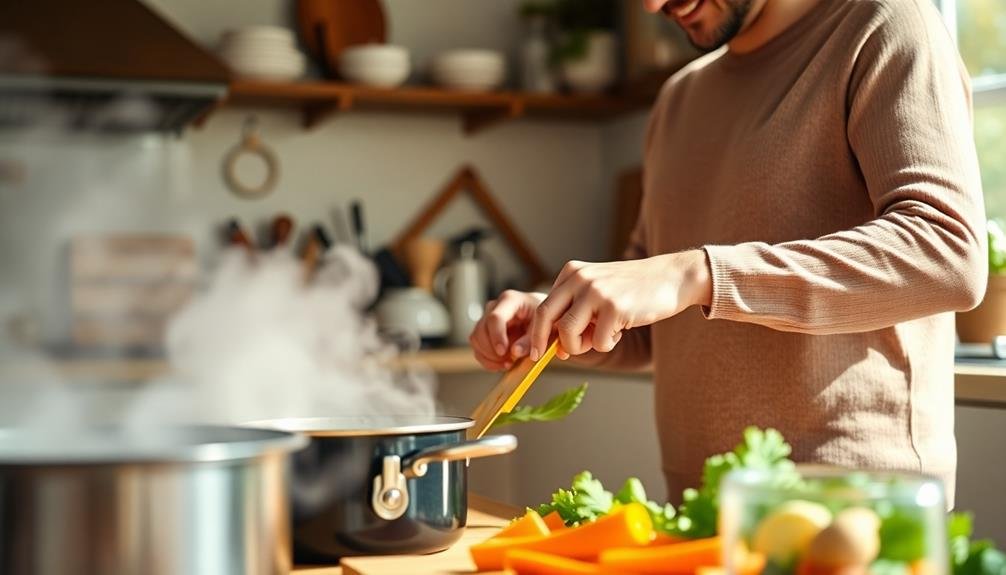
Embrace the art of slow cooking to find tranquility in the kitchen. As you chop vegetables, stir sauces, or knead dough, focus on the rhythmic motions and let your mind unwind. Mindful cooking techniques can help you stay present and calm your racing thoughts. Pay attention to the sights, smells, and textures of your ingredients as you work with them.
Try incorporating gentle breathing exercises while you cook. Inhale deeply as you add spices, and exhale slowly as you stir. This simple practice can help lower your heart rate and reduce anxiety.
Another relaxation technique is to engage in repetitive tasks, like peeling potatoes or rolling out dough. These actions can be meditative and soothing.
Remember, cooking for relaxation isn't about perfection or speed. It's about enjoying the process and finding peace in the kitchen. Here are some key points to keep in mind:
- Focus on the sensory experience of cooking
- Use cooking as a form of moving meditation
- Practice gratitude for the ingredients and the act of nourishing yourself
- Allow yourself to be fully present in the moment, letting go of worries
Aromatherapy Through Culinary Herbs
The kitchen's aromatic herbs offer more than just flavor—they're natural stress-busters too. As you cook, you'll find that certain herbs can greatly reduce anxiety through their scents. Basil, for instance, has a calming effect that can lower cortisol levels. When you chop fresh basil or add it to your dishes, you're not just seasoning—you're creating a soothing atmosphere.
Rosemary is another powerful herb that can enhance mental clarity and reduce stress. Its pine-like aroma can boost your mood and improve cognitive function. Try infusing olive oil with rosemary or using it in roasted vegetables.
Lavender, while not commonly used in cooking, can be incorporated into baked goods or teas for its renowned relaxation properties. Mint's revitalizing scent can invigorate your senses and alleviate tension. Use it in salads, drinks, or as a garnish.
Thyme contains carvacrol, a compound that can increase feelings of well-being. Add it to soups or roasted meats to benefit from its aromatic properties. By consciously using these herbs in your cooking, you're creating a multi-sensory experience that can greatly reduce anxiety.
Shared Kitchen Tasks and Communication
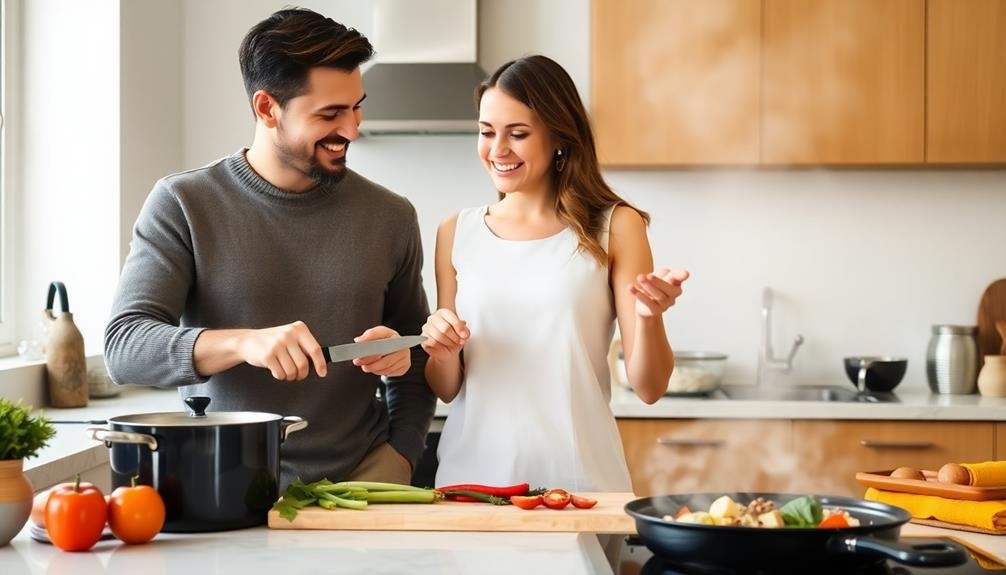
Cooking as a team creates opportunities for open communication and shared responsibility. When you work together in the kitchen, you're naturally inclined to talk, share ideas, and solve problems collaboratively. This process can help reduce anxiety by fostering a sense of connection and mutual support.
Assign specific tasks to each person based on their strengths and preferences. One might chop vegetables while another stirs the pot. This division of labor not only makes the cooking process more efficient but also allows each person to feel valued and contribute meaningfully.
As you work side by side, you'll find that conversation flows more easily, creating a relaxed atmosphere that can help alleviate stress and anxiety.
Consider these benefits of shared kitchen tasks and communication:
- Builds trust and strengthens relationships
- Encourages active listening and empathy
- Provides a non-threatening environment for difficult conversations
- Teaches cooperation and compromise skills
Savoring the Process Together
As you cook together, focus on mindful meal preparation to enhance the anxiety-relieving benefits.
Pay attention to the textures, aromas, and colors of ingredients as you chop, stir, and season.
Creating shared culinary experiences can deepen your connection and provide a sense of accomplishment, further reducing stress and anxiety.
Mindful Meal Preparation
During meal preparation, mindfulness can transform a routine task into a therapeutic experience. As you cook together, focus on each step of the process, engaging all your senses. Notice the vibrant colors of fresh produce, inhale the aroma of herbs and spices, and feel the texture of ingredients as you chop and mix.
Listen to the sizzle of a pan or the gentle bubbling of a simmering pot. This sensory awareness can help ground you in the present moment, reducing anxiety and stress.
Encourage your cooking partner to join you in this mindful approach. Together, you can create a peaceful atmosphere in the kitchen, free from distractions like phones or TV. Take turns leading different cooking tasks, allowing each person to fully immerse themselves in the activity at hand.
This shared focus can strengthen your connection and promote a sense of calm.
Here are four benefits of mindful meal preparation:
- Reduces stress and anxiety by promoting present-moment awareness
- Enhances appreciation for food and its origins
- Improves focus and concentration skills
- Fosters a deeper connection with your cooking partner
Shared Culinary Experiences
Three key aspects make shared culinary experiences a powerful tool for anxiety relief: connection, creativity, and accomplishment. When you cook with others, you're not just preparing food; you're building relationships and creating memories. You'll find that the act of collaboration reduces feelings of isolation and promotes a sense of belonging.
As you work together, you'll tap into your collective creativity. Brainstorming recipe ideas, experimenting with flavors, and problem-solving kitchen challenges can be exhilarating. This creative process helps shift your focus away from anxious thoughts and towards the present moment.
Finally, the shared sense of accomplishment when you complete a dish together can boost your confidence and self-esteem. Here's a breakdown of the benefits:
| Aspect | Benefit | Anxiety-Reducing Effect |
|---|---|---|
| Connection | Strengthens relationships | Decreases loneliness |
| Creativity | Stimulates the mind | Redirects focus |
| Accomplishment | Boosts self-esteem | Increases confidence |
| Teamwork | Enhances communication | Improves social skills |
Mindful Eating and Appreciation
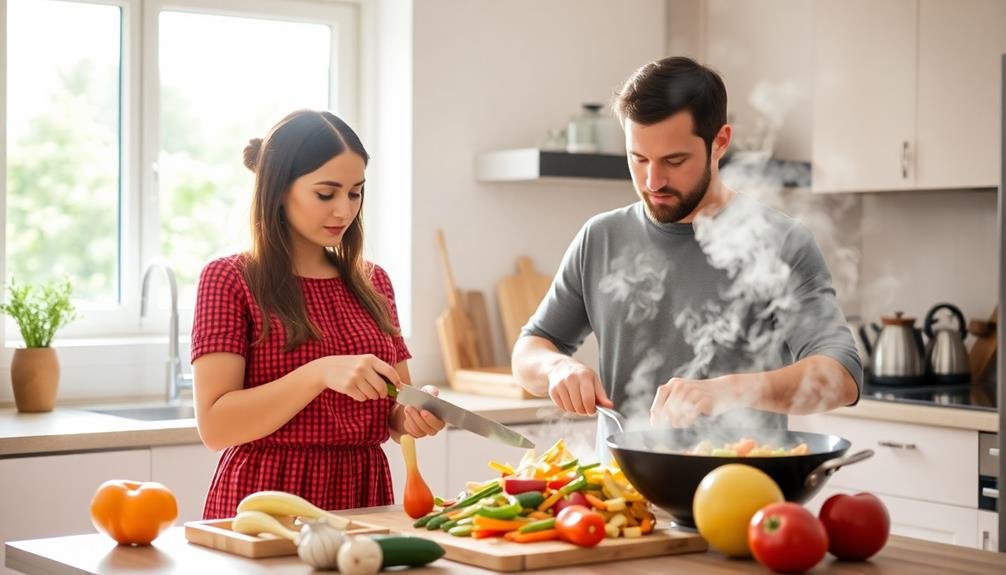
Mindful eating and appreciation form an essential part of the cooking and dining experience. When you're cooking together, you're not just preparing a meal; you're creating an opportunity for mindfulness and gratitude.
As you sit down to enjoy the fruits of your labor, take a moment to truly savor each bite. Notice the flavors, textures, and aromas of the food you've prepared.
Practicing mindful eating can help reduce anxiety by grounding you in the present moment. It allows you to focus on the sensory experience of eating, rather than worrying about past or future concerns.
Additionally, expressing appreciation for the meal and the company can foster a sense of connection and positivity.
To enhance your mindful eating practice and appreciation, consider the following:
- Take a few deep breaths before starting your meal
- Eat slowly, chewing each bite thoroughly
- Engage in conversation about the food's flavors and preparation
- Express gratitude for the ingredients, effort, and shared experience
Building Confidence Through Culinary Skills
As you develop your culinary skills, you'll likely notice a boost in your overall confidence. Mastering new recipes and techniques empowers you to take on challenges both in and out of the kitchen. Start with simple dishes and gradually progress to more complex ones. Each successful meal you prepare reinforces your ability to learn and grow.
Cooking allows you to express creativity and problem-solving skills. You'll learn to adapt recipes, substitute ingredients, and troubleshoot when things don't go as planned. These experiences translate into real-life situations, helping you approach obstacles with a can-do attitude.
As your skills improve, you'll feel more comfortable experimenting and taking risks in the kitchen. This newfound confidence can spill over into other areas of your life, encouraging you to try new things and push your boundaries.
Sharing your culinary creations with others further bolsters your self-esteem. Receiving compliments and appreciation for your efforts reinforces your sense of accomplishment.
You'll begin to see yourself as capable and resourceful, traits that are invaluable in managing anxiety and facing life's challenges head-on.
Frequently Asked Questions
Can Cooking Therapy Be Effective for Severe Anxiety Disorders?
Cooking therapy can be effective for severe anxiety disorders. You'll find it can help reduce stress, improve focus, and boost self-esteem. It's a hands-on approach that engages your senses and promotes mindfulness, potentially easing anxiety symptoms.
How Often Should One Engage in Cooking Therapy for Optimal Results?
You'll want to engage in cooking therapy at least 2-3 times a week for ideal results. It's best to make it a regular part of your routine, but don't push yourself too hard. Listen to your body and adjust accordingly.
Are There Specific Cuisines That Work Better for Anxiety Relief?
You'll find that any cuisine can help with anxiety relief. However, comfort foods from your childhood or simple, hands-on recipes like bread-making or pasta-rolling might be particularly soothing. Choose dishes you enjoy and feel confident preparing.
Can Cooking Therapy Be Combined With Other Forms of Anxiety Treatment?
Yes, you can combine cooking therapy with other anxiety treatments. It's a versatile approach that complements traditional therapies, mindfulness practices, and medication. You'll find it enhances your overall treatment plan, providing a hands-on, sensory-rich coping strategy for anxiety.
Is Cooking Therapy Suitable for Individuals With Food-Related Anxieties or Disorders?
If you're dealing with food-related anxieties, cooking therapy might be challenging initially. However, it can be adapted to suit your needs. You'll want to work closely with a therapist to guarantee it's beneficial and doesn't exacerbate your concerns.
In Summary
You've discovered a powerful tool for anxiety relief through cooking together. By embracing this shared experience, you're not just creating meals; you're building stronger connections and fostering a sense of calm. Remember, it's not about perfection but the journey. As you continue to explore cooking therapy, you'll find your kitchen becoming a sanctuary of peace and creativity. Keep experimenting, stay mindful, and savor every moment of this delicious path to wellness.





Leave a Reply